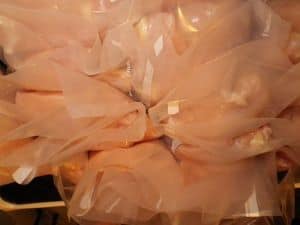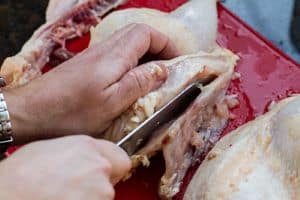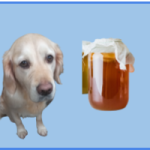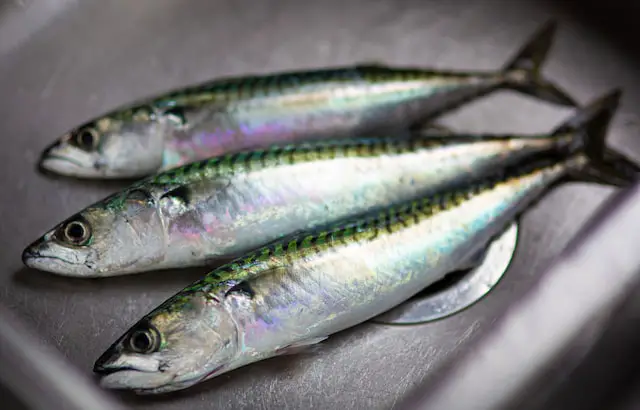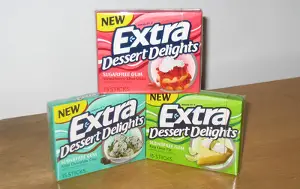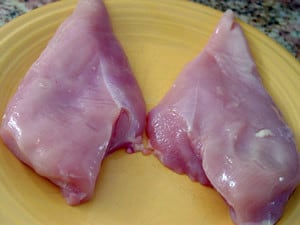
Although a raw chicken breast is a tasty, quick, nutritious and quite economical way to give your dog a treat, lots of raw chicken contains very harmful bacteria.
Raw chicken is thought to be responsible for 1 in every 4 food poisonings in the USA.
And OK that is a statistic about people, not dogs.
But dogs can become ill by consuming contaminated chicken as I highlight later.
My advice would be to cook chicken breast where possible.
And if you want to find out how I have come to that conclusion, read on!
The dangers of feeding raw chicken breast
Raw chicken might contain a few different types of harmful bacteria, whether the breast is fresh or past its sell by date.
The harmful bacteria can be killed in a fresh piece of chicken breast by cooking it, whereas cooking an out of date chicken breast won’t kill any of the harmful stuff.
And potentially by feeding your dog raw chicken you are not just putting them in danger, you are putting yourself in danger by handling it.
And if you don’t clean up and clear up thoroughly enough, you might be poisoning the rest of your house?
If that sounds grim, I’m sorry.
But let me give you the dirty low down on raw chicken- remembering that this applies to all the meat, not just the breast.
Three bacteria in raw chicken

The most common bacteria found in raw chicken is Campylobacter.
It is estimated that this bacteria might be in up to 24% of all raw chicken.
The main symptoms of campylobacter in dogs are: watery diarrhea, vomiting or straining to go to the toilet.
Other common ways that dogs can become infected with campylobacter is by coming into contact with infected faeces from other dogs.
The next bacteria that hides in raw chicken is salmonella.
In a 2012 survey in the US, salmonella was found in 26.3% of all chicken parts.
As a contrast, the rate in the UK was 5.8% in 2001.
Symptoms in your dog might include; diarrhea, vomiting and lethargy.
Dogs are less likely to suffer from salmonella poisoning than they are to pass it onto people!
The third resident bacteria is C.perfringens and this too can cause diarrhea.
All three bacteria can be killed by cooking chicken properly, which means making sure that the internal temperature gets to 165 °F.
In terms of keeping yourself safe whilst handling it, don’t be tempted to wash the chicken but do make sure that you wash your hands after handling it.
The nutrients in raw chicken breast
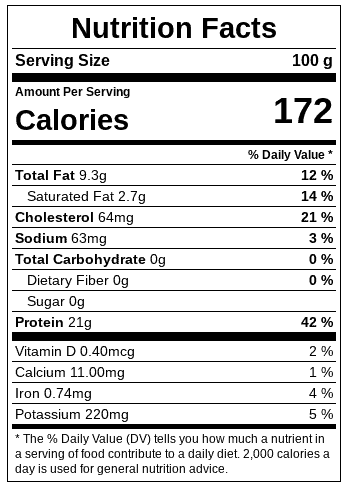
Looking at the nutrition label for raw chicken, in every 100g serving there is just over 9% fat and 21% protein.
Now the daily values are a bit confusing because they are calculated on the nutritional needs of a person not a dog.
But we know that a dog needs a diet that contains 45% protein and nearly 14% fat- so raw chicken breast fulfils part of these needs.
Other ways that raw chicken breast helps your dog is with the vitamins and minerals that it contains.
There are too many minerals and vitamins to mention them all and so I will just focus on those that chicken breast contains most of.
Mineral wise, chicken breast provides part of what a dog needs in terms of iron and zinc.
It is less great when it comes to copper.
Chicken breast is a great source of vitamin A, vitamin B1, B2 and B5 for a dog.
Does cooking the chicken breast change it?
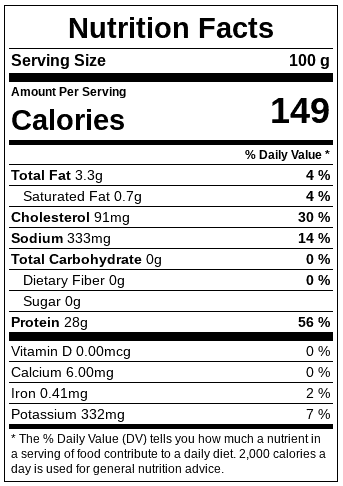
Looking at the information on the nutrition of cooked chicken breast, the protein increases (from 21% to 27%) and the fat reduces (from 9.3% to 7.4%).
But what happens to the minerals and vitamins in cooked chicken?
The unfortunate thing is that for most minerals and vitamins, cooking the meat results in a reduction.
The good news is that for most vitamins and minerals this isn’t by much.
What is the best way of cooking chicken breast for your dog?
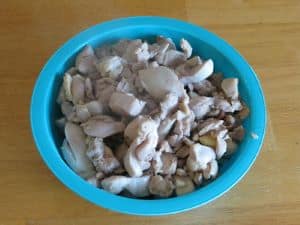
So have I persuaded you to start thinking of an alternative way of feeding chicken breast to your dog.
I know, I feel your pain.
Cooking chicken breast takes longer and involves more mess.
And that is a fact.
But what is the best way of cooking it?
If we are aiming for a quick and easy combination that preserves as many nutrients within the chicken as possible then our best option is boiling or poaching it.
It is the easiest method because you just need a pan and boiling water and it is the “best” method because it cooks the chicken in the lightest way possible.
Depending on the size of the chicken breast, this will take between 10 and 15 minutes.
But to be sure check the thickest part of the meat with a thermometer.
Does freezing chicken breast kill the bacteria?
OK, so you grudgingly admit to some of what I’m saying.
But, now you have thought of something else- another way to feed raw chicken.
How about feeding my dog frozen raw chicken?
Surely freezing it kills the bacteria?
No, smart idea but freezing bacteria only well…freezes it.
And if you give your dog a frozen piece of chicken to eat your dog might break a tooth biting into it.
To be honest, I have been guilty of feeding one of my dogs frozen raw chicken breasts seven or eight years ago.
When she was pregnant, we were looking for ways to feed her more protein and we opted for chicken breasts because they are high in protein, relatively cheap and tasty.
For a few weeks we fed Mia a raw or frozen chicken breast everyday to help her along.
She didn’t get sick from bacteria and she didn’t break any teeth and so I think, with hindsight, we were lucky.
Still your mind is whirring as you are trying to solve the riddle- how to keep my dog safe whilst still feeding them raw chicken.
Well, what about raw chicken bones? Let’s find out..
Are raw chicken bones safe for dogs?
It is probably safer to feed your dogs raw chicken bones rather than raw chicken breast.
Raw bones are much safer for dogs to eat than cooked bones because they are much less likely to splinter into little pieces.
But chicken bones are quite small for most dogs and could become a choking hazard.
Just picture in your mind a dog chewing on a leg of a chicken and a dog chewing on the part of the leg of a cow.
Chicken bones are dangerous because in a couple of bites (if that) the dog might swallow it and choke on them.
But a beef bone? Now that is larger and something to savour!
If you want to get a raw bone for your dog, you are best to opt for bones from larger animals such as a pig or a cow.
And to make sure that you choose weight bearing bones, such as leg bones.
These bones tend to be more robust and less likely to splinter in a dog’s mouth.
Should I feed my puppy raw chicken breast?
Most food related questions with dogs also have lots of people asking similar questions relating to their puppies.
And as far as raw chicken breast goes or raw chicken anything when it comes to puppies the answer is “no.”
Even the biggest and sturdiest puppies are more vulnerable to any infection or disease because their immune systems haven’t developed fully.
They aren’t operating at 100%.
And you could easily say the same of senior dogs or dogs with an underlying health condition.
Don’t risk it.
Just poach the bloody thing!
Skin or skinless chicken breast?
Roasted chicken skin is a must for most people as they sit down and eat their Sunday roast.
It gives a little something extra to the flavour and texture of the meat.
But what does it do for dogs?
Most people would say don’t feed it to your dog because it is just “all fat”.
Which isn’t quite true because it is only 40% fat and 20% protein.
I would say feed it to your dog in moderation.
If they regularly eat chicken breast then every so often include a bit of skin.
Can I feed my dog too much chicken breast?
This all depends on what you mean by too much.
As we saw earlier, chicken breast doesn’t contain everything that a dog needs in their diet, it doesn’t have the right balance of nutrients.
So, in that sense you can feed your dog too much.
Just as you can feed your dog too much raw chicken because the more you feed your dog, the greater the chance of it becoming sick with campylobacter or salmonella.
Feed your dog chicken in moderation and try to add variety to their diet but using different meats and vegetables.

